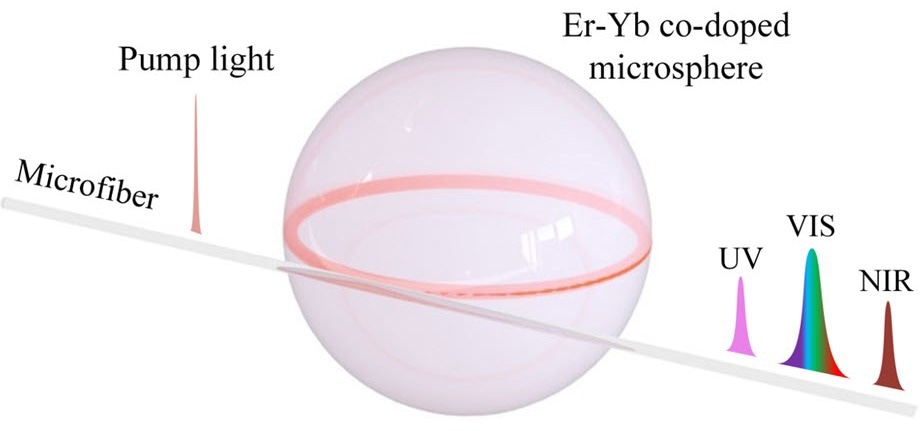Applications such as full-color displays, optical communications, and computation all depend on microlasers with many lasing bands. The plentiful long-lived intermediate energy levels and intraconfigurational transitions provided by rare earth (RE) elements are essential for emissions over a variety of lightwave bands.
 Simultaneous ultraviolet, visible, and near-infrared CW lasing at room temperature. Image Credit: B. Jiang et al.
Simultaneous ultraviolet, visible, and near-infrared CW lasing at room temperature. Image Credit: B. Jiang et al.
By pumping photons via the lasing processes known as “downshifting” to reduce the frequency, and “upconversion,” to raise the energy, it is feasible to produce deep ultraviolet to mid-infrared light.
Although upconversion has some special benefits, such as deeper penetration and lesser ionization damage, it is typically more challenging than downshifting. The emission wavelength range can be expanded for the highest potential by combining downshifting and upconversion.
Ultrahigh-Q Rare-Earth-Doped Microcavity
Researchers have wondered whether it might be possible to build a multiband laser by incorporating or “doping” RE elements into an ultrahigh-Q microcavity without lowering its intrinsic Q factor, as using REs for upconversion eradicates the requirement for strict phase-matching conditions or high pump density.
A team from Huazhong University of Science and Technology (HUST) used polymer-assisted thermal doping to create RE-doped microcavities with ultrahigh intrinsic Q factors above 108, as described in the journal Advanced Photonics.
According to reports, the doping procedure does not cause any noticeable ion clustering or scattering loss. It is a natural platform for generating lasing and other nonlinear phenomena with minimal power requirements due to its extremely high inherent Q factor.
Multiband Lasing at Room Temperature
To minimize thermal damage to obtain materials and resonant cavities, a study for high-order upconversion lasers often uses a pulsed laser pump in a cryogenic environment. This is the first instance of constant upconversion lasing in the ultraviolet and violet from RE elements.
The HUST team pumped a continuous-wave 975-nm laser into a microcavity after doping it with erbium and ytterbium. The resulting laser covers the ultraviolet, visible, and near-infrared bands with a wavelength range of around 1170 nm.
The group calculated that all lasing thresholds were below milliwatts. The microlasers demonstrated good intensity stability over 190 minutes, qualifying them for use in real-world scenarios.
This demonstration highlights the potential for RE elements to produce stable multiband lasing. While erbium and ytterbium were used in this study, other RE elements, like thulium, holmium, and neodymium, may enable adaptable pump schemes and a wealth of lasing wavelengths.
The ultrahigh-Q doped microcavity may also provide a good platform for ultrahigh-precision sensing and research into cavity-matter-light interactions, in addition to its benefits for laser applications.
Journal Reference
Jiang, B., et al. (2022) Simultaneous ultraviolet, visible, and near-infrared continuous-wave lasing in a rare-earth-doped microcavity. Advanced Photonics. doi.org/10.1117/1.AP.4.4.046003.